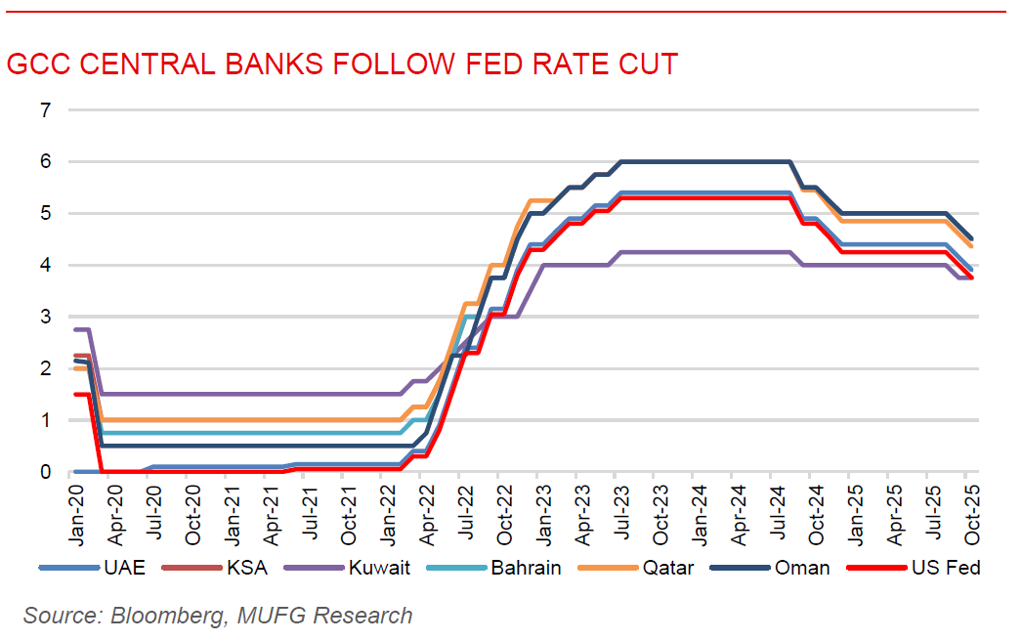To read the full report, please download the PDF above.
Middle East Daily
SOOJIN KIM
Research Analyst
DIFC Branch – Dubai
T: +44(4)387 5031
E: soojin.kim@ae.mufg.jp
MUFG Bank, Ltd. and MUFG Securities plc
A member of MUFG, a global financial group
Middle East Daily
COMMODITIES / ENERGY
Oil slips after Trump-Xi meeting shows progress but omits energy talks. Oil prices fell, with Brent below USD65/b and WTI near USD60/b, after the Trump-Xi summit in South Korea concluded with progress on several trade issues but no discussion on oil. The US had imposed new sanctions on major Russian producers before the meeting, and Trump said he planned to urge China to scale back Russian crude imports. Despite optimism over easing US-China tensions, crude remains headed for a third consecutive monthly decline, pressured by expectations of rising supply from OPEC+ and rival producers. The IEA warned of a potential record surplus in 2026, though Saudi Aramco maintained a more upbeat outlook. The next OPEC+ meeting on November 2 is expected to consider modest output increases, adding to traders’ concerns about oversupply.
Gold rebound as traders assess Trump-Xi trade outcome and Fed signals. Gold rose up to 1.3% to near USD3,982/oz after four sessions of losses, as investors digested comments from President Trump following his meeting with President Xi. The talks produced a limited trade deal, including halved fentanyl tariffs and the resumption of soybean imports, easing tensions between the world’s two largest economies but falling shorts of a full agreement. The partial resolution reduced uncertainty that had weighed on markets, yet ongoing doubts about global policy direction kept demand for gold alive. Meanwhile, Fed divisions added complexity for traders after Chair Powell played down the changes of another rate cut in December despite dissent among policymakers. Investors await the World Gold Council’s demand report for clues on institutional and central bank appetite following ETF outflows earlier this week.
MIDDLE EAST - CREDIT TRADING
End of day comment – 29 October 2025. In Saudi Arabia, the long end of the curve slightly underperformed, which was a rare occurrence. Asian brokers were active buyers early in the session, yet spreads remained heavy throughout the day. Short- and medium-term curves showed no such weakness, while off-the-run bonds in the five- to ten-year range outperformed the rest of the curve. This dynamic didn't spread to ARAMCO or PIFKSA. We did see a bounce in KSA sub debt today getting lifted on RIBL 35s, RJHIAB Perps and SNBAB 35s. We also marked the ALINMA AT1 curve (lol) 8bps tighter. We are bumping up against the LT2 levels do not make sense vs. AT1 in various point, namely RIBL and RJHIAB Perps vs. anything else. In Bahrain Strange action with the long end still bid from yesterday but new 37s offered down in zspd into where the 44s are trading. Feels like a dealer trying hard to get hit in 44s. Short end resisted the rates move and is going out 3-5bps tighter and 0.05-0.1 higher in cash. Long end + ½pt or 6-9bps tighter. In Turkey, the market is sneaking for risk here. No big eye popping bids, but scraps coming out on rebalance trading at or above the offered side. YKBNK in particular about 15bps tighter both senior and subs, but other banks sub debt -15bps as well.
MIDDLE EAST - MACRO / MARKETS
GCC central banks follow Fed rate cut to support monetary alignment. Following the US Fed’s 25bps rate cut, all GCC central banks, except Kuwait, moved in tandem to ease monetary policy in line with their dollar-pegged exchange rate frameworks. The Saudi Central Bank (SAMA) lowered its repo rate to 4.5% and the reverse repo rate to 4.0%, while the central Bank of the UAE reduced its base rate to 3.90% from 4.15%. Qatar’s central bank (QCB) trimmed its lending and repo rates by 25bps to 4.6% and 4.35% respectively. Both Oman and Bahrain followed suit, cutting their key rates to 4.5%. The coordinated policy easing reflects the GCC’s continued effort to maintain exchange rate stability, support liquidity, and ensure monetary conditions remain conducive to sustained economic growth amid global shifts in interest rate trajectory.
Syria draws USD28bn in investments amid economic reform push. Syria announced that it has attracted approximately USD28bn in foreign investments in the first ten months of 2025, signalling a renewed push to rebuild its war-damaged economy through structural reforms. The announcement came during the Future Investment Initiative (FII) in Riyadh, where Syrian officials highlighted a series of newly implemented investment laws designed to facilitate capital inflows, including guarantees on profit repatriation and the free transfer of foreign currency. These changes aim for restore investor confidence, modernise Syria’s financial and industrial infrastructure, and reopen trade channels with regional partners after years of isolation. The influx of investment, largely directed toward energy infrastructure, manufacturing, and logistics, reflects growing regional interest in participating in Syria’s economic recovery, while also testing the limits of international sanctions and the country’s ability to sustain policy and regulatory stability moving forward.

